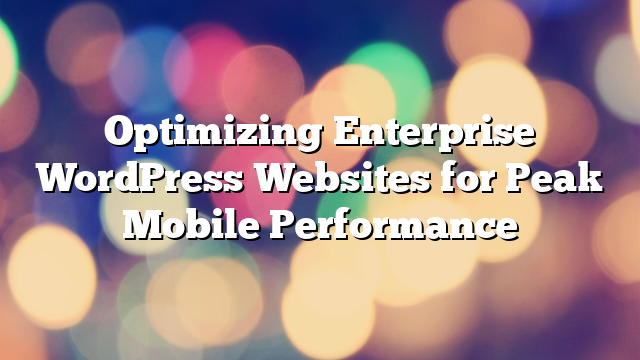Optimizing Enterprise WordPress Websites for Peak Mobile Performance
24.04.2025

With more than half of all global web traffic now coming from mobile devices, ensuring that your enterprise WordPress website delivers a seamless mobile experience is no longer optional—it’s mission-critical. Poor mobile performance doesn’t just hurt user experience; it directly impacts SEO, engagement, and conversions. For large-scale businesses, the stakes are even higher.
Why Mobile Optimization Matters for Enterprises
Enterprise websites often serve as digital headquarters—providing information, onboarding customers, supporting products, and driving sales. If mobile users are met with sluggish load times, broken layouts, or difficult navigation, they won’t hesitate to bounce. Google also prioritizes mobile-first indexing, meaning your mobile performance can make or break your search visibility.
Responsive Design: The Foundation of Mobile UX
Responsive design ensures your site looks and functions well across all screen sizes. Modern WordPress themes (especially custom or Headless implementations) should use flexible grids, scalable typography, and adaptive images to accommodate various devices. Regular testing across different screen sizes is essential, especially when using dynamic content or custom components.
Critical Mobile Performance Metrics to Monitor
Google’s Core Web Vitals provide a clear framework for mobile performance optimization:
- Largest Contentful Paint (LCP): How quickly the main content becomes visible.
- First Input Delay (FID): How responsive your site is to user interaction.
- Cumulative Layout Shift (CLS): How visually stable the page is during load.
Tools like Lighthouse, PageSpeed Insights, and GTmetrix help diagnose and improve these metrics specifically for mobile.
Techniques to Boost Mobile Speed
Here are advanced techniques enterprises can implement to ensure peak mobile performance:
- Use Adaptive Image Delivery: Serve different image sizes based on device using plugins or a CDN with automatic optimization.
- Implement Lazy Loading: Load images and media only when they’re about to appear in the viewport.
- Minify and Combine Assets: Reduce CSS, JavaScript, and HTML file sizes for faster rendering.
- Leverage a Mobile CDN: Deliver content faster to users based on their location and device type.
AMP vs. Responsive Design: What’s Right for You?
Google’s AMP (Accelerated Mobile Pages) framework strips down pages for speed but often limits customization and branding. For enterprises with high design standards and dynamic content, a fully optimized responsive experience with selective AMP implementation (such as for blogs or articles) may offer the best balance between performance and flexibility.
Testing and Continuous Improvement
Enterprise websites should undergo regular audits for mobile UX and speed. Conduct user testing on real devices and use session recordings to identify pain points. Combine quantitative data (bounce rate, time on site) with qualitative insights to prioritize improvements.
Conclusion
Mobile optimization for enterprise WordPress sites isn’t just about shrinking content—it’s about delivering fast, intuitive, and consistent experiences across all devices. With strategic planning and expert implementation, enterprises can turn mobile traffic into loyal users and measurable ROI.
Looking to improve your WordPress mobile performance? Vipe Studio offers performance audits, optimization strategies, and enterprise-grade development. Contact us today to get started with a faster, better mobile experience.



